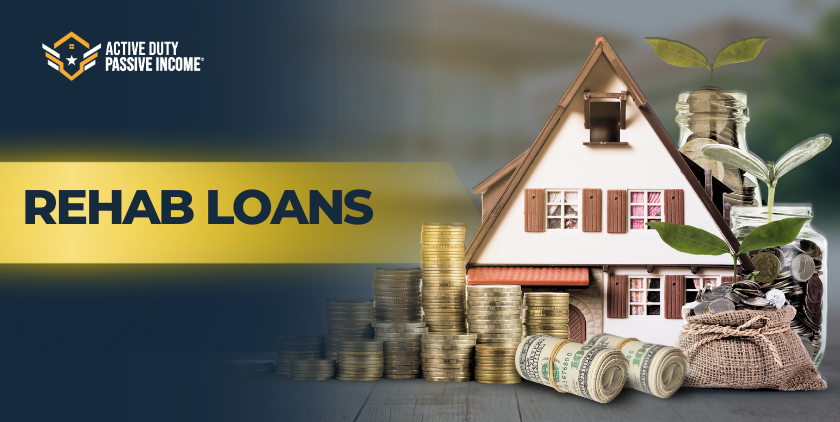Unlock the hidden potential of distressed properties and transform them into valuable assets with the power of rehab loans!
Real estate investing has always been a popular strategy for building wealth and achieving financial independence. However, entering the market can be daunting, especially when dealing with properties that need significant repairs or renovations. This is where rehab loans come into play. These specialized loans provide investors and homebuyers the funds necessary to purchase and renovate properties, transforming them into valuable assets. In this comprehensive blog post, we will explore everything you need to know about rehab loans, including their types, benefits, application process, and how they can help you succeed in the real estate market.
Understanding Rehab Loans
Rehab loans, also known as renovation loans, are designed to finance the purchase and improvement of properties that require repairs or upgrades. These loans combine the costs of purchasing the property and funding the necessary renovations into a single mortgage. This makes it easier for buyers and investors to secure the funds needed to turn distressed or outdated properties into desirable homes or profitable investments.
Types of Rehab Loans
There are several types of rehab loans available, each catering to different needs and scenarios. The most common types include:
1. FHA 203(k) Loan
The Federal Housing Administration (FHA) offers the 203(k) loan, which is one of the most popular rehab loan options. This loan is ideal for homebuyers looking to purchase and renovate a primary residence. There are two versions of the FHA 203(k) loan:
- Standard 203(k): Suitable for major renovations and structural repairs, with a minimum required cost of $5,000.
- Limited 203(k): Designed for smaller projects, such as cosmetic repairs and non-structural improvements, with a maximum limit of $35,000.
2. Fannie Mae HomeStyle Renovation Loan
The Fannie Mae HomeStyle Renovation loan is another popular option for homebuyers and investors. This conventional loan allows borrowers to finance the purchase and renovation of a property with a single mortgage. Unlike the FHA 203(k) loan, the HomeStyle Renovation loan can be used for primary residences, second homes, and investment properties. It also offers more flexibility in terms of the types of renovations that can be funded.
3. Freddie Mac CHOICERenovation Loan
Similar to the Fannie Mae HomeStyle Renovation loan, the Freddie Mac CHOICERenovation loan allows borrowers to finance the purchase and renovation of a property with a single loan. This loan is available for primary residences, second homes, and investment properties. It also offers the added benefit of allowing borrowers to include resilience improvements, such as flood or wind mitigation, in the renovation budget.
4. Hard Money Loans
Hard money loans are short-term, asset-based loans provided by private lenders. These loans are often used by real estate investors to finance the purchase and renovation of distressed properties. Hard money loans typically have higher interest rates and shorter repayment terms compared to traditional rehab loans. However, they offer quicker approval and funding, making them a popular choice for investors looking to capitalize on time-sensitive opportunities.
Benefits of Rehab Loans
Rehab loans offer several benefits for homebuyers and investors looking to purchase and renovate properties:
1. Simplified Financing
By combining the purchase price and renovation costs into a single loan, rehab loans simplify the financing process. Borrowers do not need to secure separate loans for the acquisition and renovation of the property, reducing the complexity and paperwork involved.
2. Increased Property Value
Renovating a distressed or outdated property can significantly increase its value. Rehab loans provide the necessary funds to make improvements, turning a property with potential into a valuable asset. This can lead to higher resale prices or increased rental income for investors.
3. Affordable Financing Options
Rehab loans, particularly those backed by government programs like the FHA 203(k) loan, often come with competitive interest rates and favorable terms. This makes them an affordable financing option for homebuyers and investors looking to undertake renovation projects.
4. Flexibility in Renovation Projects
Rehab loans offer flexibility in terms of the types of renovations that can be funded. From cosmetic upgrades to major structural repairs, borrowers can use the loan funds to address various aspects of the property that need improvement. This allows for a tailored approach to renovation, ensuring that the property meets the buyer’s or investor’s specific needs and goals.
The Application Process
Applying for a rehab loan involves several steps, and understanding the process can help borrowers navigate it more efficiently. Here is a general overview of the application process for rehab loans:
1. Pre-Approval
Before starting the property search, it is advisable to get pre-approved for a rehab loan. This involves meeting with a lender to discuss your financial situation, credit score, and the type of rehab loan you are interested in. Pre-approval gives you an idea of how much you can borrow and helps streamline the loan application process once you find a property.
2. Property Selection and Evaluation
Once pre-approved, you can start searching for properties that fit your criteria. It is important to work with a real estate agent who understands the rehab loan process and can help you identify suitable properties. After selecting a property, you will need to conduct a thorough evaluation to determine the scope and cost of the necessary renovations.
3. Hiring a Contractor
For most rehab loans, you will need to hire a licensed contractor to provide a detailed estimate of the renovation costs. This estimate is crucial for the loan approval process, as it helps the lender determine the total loan amount. Make sure to choose a reputable contractor with experience in renovation projects similar to yours.
4. Loan Application
With the property selected and the renovation estimate in hand, you can proceed with the formal loan application. This involves submitting various documents, including your financial information, credit history, property appraisal, and the contractor’s estimate. The lender will review your application and may request additional information or documentation as needed.
5. Loan Approval and Closing
Once your loan application is approved, you will proceed to the closing process. During closing, you will sign the necessary loan documents and the funds for the purchase and renovation will be disbursed. Depending on the type of rehab loan, the renovation funds may be held in an escrow account and released in stages as the work progresses.
6. Renovation and Inspections
After closing, you can begin the renovation process. It is important to work closely with your contractor to ensure the project stays on schedule and within budget. Most rehab loans require periodic inspections to verify that the renovations are being completed according to the approved plan. The lender will release the funds in stages based on the progress of the work.
Tips for Success with Rehab Loans
Successfully navigating the rehab loan process and completing a renovation project requires careful planning and execution. Here are some tips to help you succeed with rehab loans:
1. Do Your Research
Before diving into a rehab project, take the time to research different types of rehab loans and their requirements. Understanding the pros and cons of each loan option will help you choose the one that best fits your needs and goals.
2. Budget Wisely
Creating a detailed budget for your renovation project is essential. Be sure to account for all potential costs, including materials, labor, permits, and contingencies. Having a realistic budget will help you avoid financial surprises and ensure that you have enough funds to complete the project.
3. Choose the Right Property
Selecting the right property is crucial for the success of your rehab project. Look for properties with good potential for value appreciation and consider factors such as location, market demand, and the extent of repairs needed. Working with a knowledgeable real estate agent can help you identify properties that align with your investment strategy.
4. Work with Experienced Professionals
Hiring experienced professionals, including a real estate agent, contractor, and lender, can make a significant difference in the success of your rehab project. Their expertise and guidance will help you navigate the complexities of the rehab loan process and ensure that your project is completed to a high standard.
5. Monitor the Project Closely
Staying involved and monitoring the progress of your renovation project is important. Regularly communicate with your contractor and address any issues or concerns promptly. Periodic inspections and progress reports will help you stay on track and ensure that the project is completed within the agreed timeline and budget.
Conclusion
Rehab loans are a powerful tool for homebuyers and investors looking to purchase and renovate properties. By providing the necessary funds to transform distressed or outdated properties into valuable assets, rehab loans offer a pathway to building wealth and achieving financial goals. Understanding the different types of rehab loans, the application process, and tips for success will help you make informed decisions and maximize the potential of your real estate investments.
Whether you are a first-time homebuyer looking to create your dream home or an experienced investor seeking profitable opportunities, rehab loans can open the door to a world of possibilities in the real estate market. With careful planning, research, and the right team of professionals, you can turn your vision into reality and reap the rewards of your hard work and dedication.









